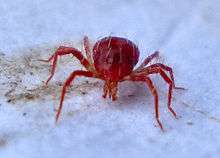Phytoseiulus
| Phytoseiulus | |
|---|---|
 | |
| Phytoseiulus persimilis | |
| Scientific classification | |
| Kingdom: | Animalia |
| Phylum: | Arthropoda |
| Class: | Arachnida |
| Subclass: | Acari |
| Superorder: | Parasitiformes |
| Order: | Mesostigmata |
| Family: | Phytoseiidae |
| Subfamily: | Amblyseiinae |
| Genus: | Phytoseiulus Evans, 1952 |
Phytoseiulus is a genus of mites in the Phytoseiidae family.[1] A predatory mite, this is the mite predator most frequently used to control two-spotted spider mites in greenhouses and outdoor crops grown in mild environments. This mite was accidentally introduced into Germany from Chile in 1958; it was subsequently shipped to other parts of the world, including California and Florida, from Germany. A Phytoseiulus mite can consume up to seven adult spider mites or several dozen of their eggs in a day. Adult females are reddish, pear-shaped, about 0.5 mm long, and active at room temperature. Immatures and males are smaller and lighter in color. Eggs are oblong. About 80% are females. At optimum temperatures, Phytoseiidae can develop from egg to adult in 7 days and live up to a month. A well-fed female lays about 50 eggs in her lifetime.
Environment
Ideal temperature range is 70–85°F (20–30°C) with relative humidity of 70–80% inside the plant canopy. Minimum temperature for activity is 50°F (10°C). This predator does best when humidity is 60% or higher with a temperature range of 55–105°F.[2]
Biology
(typical values @ 68–77°F)
sex ratio: four females/male
average eggs laid per day: 2.4
lifespan: 30–36 days - days from egg to adult: 7.5
average eggs per female: 54
population increase = 44 x in generation time of 17 days
prey consumed per day: 7 adults, 20 immatures or 25 eggs
[3]
Species
The genus Phytoseiulus contains these species:[1]
- Phytoseiulus fragariae Denmark & Schicha, 1983
- Phytoseiulus longipes Evans, 1958
- Phytoseiulus macropilis (Banks, 1904)
- Phytoseiulus persimilis Athias-Henriot, 1957
- Phytoseiulus riegeli Dosse, 1958
- Phytoseiulus robertsi (Baker, 1990)
- Phytoseiulus tardi (Lombardini, 1959)
References
- 1 2 de Moraes, Gilberto Jose. Hallan, Joel, ed. "Phytoseiidae Species Listing". Biology Catalog. Texas A&M University. Archived from the original on 12 December 2014. Retrieved 13 August 2015.
- ↑ Hydro-Gardens. "hydro-gardens Mite Control". Retrieved February 9, 2012.
- ↑ Hydro-Gardens. "Persimilis Release Instructions" (PDF). Pest Control. Retrieved February 9, 2012.
External links
http://www.ipm.ucdavis.edu/ http://www.biocontrol.entomology.cornell.edu/predators/Phytoseiulus.php
